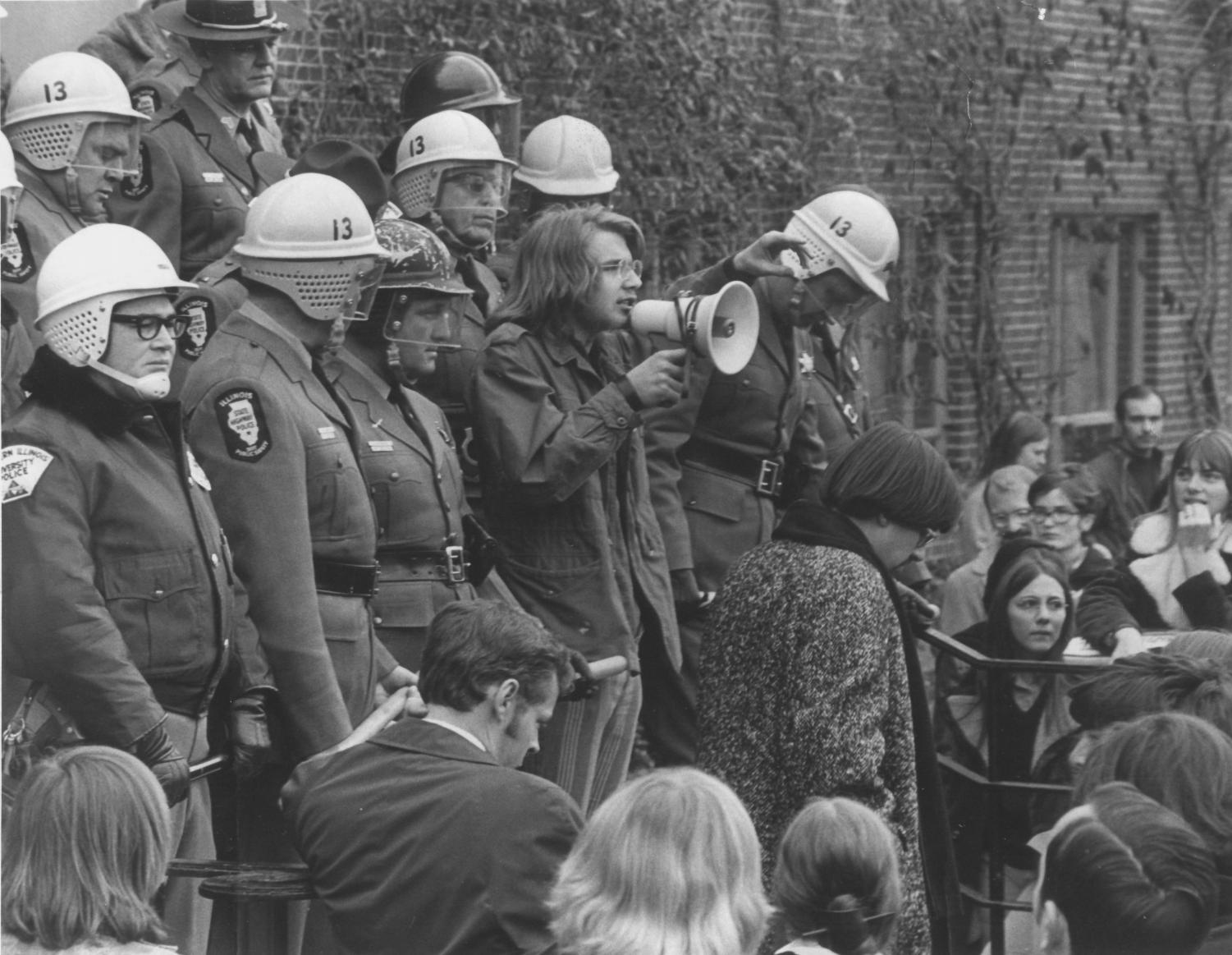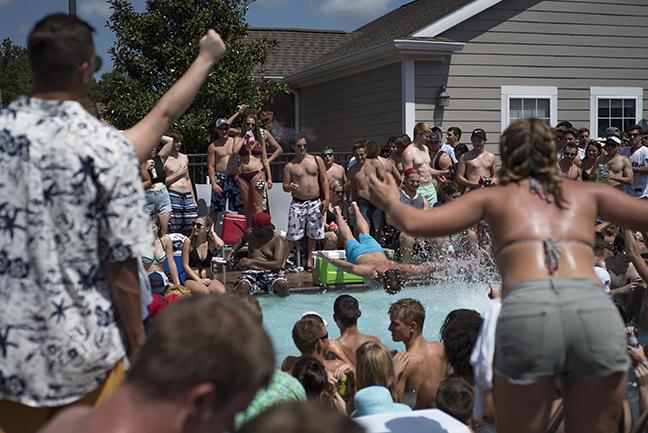Party School Era: SIU’s History of Parties and Riots
April 22, 2021
SIU has long had a reputation as a “party school.” While these parties began in the early 1900s as family fun celebrations, by the end of the 20th century the festivities began to go too far, even erupting into violent riots.
Between the 1970s and the early 2000s, it was not unusual to see a protest on the SIU campus. Many of these were of a serious political nature, as they occurred in the midst of controversies like the Vietnam War and the Kent State shootings.
In 1968, the Agriculture building was bombed, a case which was never solved. In 1969, Old Main building, which President Morris saw as a symbol of the campus he had helped to transform, was burned down. Emeritus professor Marvin Kleinau told the Daily Egyptian in 1999 these incidents were both likely the result of anti-war sentiments. By 1970, anti-war protests grew so violent the school had to be shut down temporarily, after over 400 students were arrested.
Advertisement
Even after the Vietnam War, riots continued in Carbondale, the most violent of which typically occurred during Halloween celebrations when students would “take the Strip,” an event which happened almost annually that resulted in damaged property and fights with police officers.
Jeff Doherty, who was then the Carbondale city manager, told the Daily Egyptian in 1996, “Over the past several years, we have dealt with a lot of crowds who took the Strip in the downtown area. After seeing it myself—and those who were involved from the law side also agree—this group was mean with more of an agenda to damage public property and be violent toward police than I have ever seen.”
Scott Miller was a student during the 1996 “taking the Strip” to which Doherty referred. He said he recalls the violence of the students as well as the controversial crowd-control tactics of the police, which he witnessed after taking refuge from the riot in the Corner Diner.
“The police started to tear gas the crowd outside, but the tear gas started coming in the restaurant under the door. We were shoving wet towels under the door to try to stop it. Everyone in the diner moved away from the picture windows because people were throwing bricks. I saw a car on fire—it was the Mothers Against Drunk Driving car—flipped over and engulfed,” Miller said.
Chris Novy, who was then the systems analyst of Morris Library, responded to the riots in a 1996 edition of the Daily Egyptian.
“Perhaps, if the students on the Strip this past weekend spent less time partying and more time studying, their classes wouldn’t seem as hard, and their lives would become less stressful,” Novy said.
The police force’s use of mace and tear gas to control these riots led to protests against police brutality, many of which strongly resembled the current Black Lives Matter movement. Bobby Buckley, a former SIU student, wrote a letter to the editor of the Daily Egyptian in 1996, suggesting the riots may have been more politically charged than they appeared.
Advertisement*
“While Martin Luther King Jr. waged a non-violent revolution, he was thanked by dying a violent death. While Gandhi was protesting against European domination in India peacefully, his children and his brothers died violently. Can anyone see a pattern? Non-violent protests are not effective against European domination,” Buckley said.
Many students shared Buckley’s concern about racism and violence in Carbondale. Ricky Hayward, a Black man who graduated in 2001 after playing for SIU’s football team for four years, said his coaches often warned him to be careful off campus.
“Certain groups spoke up for racial equality,” Hayward said. “As we all know, Carbondale and surrounding towns are not kind to people of color.”
With so much tension and violence, SIU needed to shut down the riots. Beginning in 2000, the university began placing restrictions on parties. Bars on the Strip were shut down and students were sent home over Halloween weekend, and there was no tolerance for wild celebration. The death of Halloween ultimately led to an end of SIU’s party school era.
The end of this era came as a disappointment to many students. Having been included in Playboy Magazine’s 1987 list of the country’s “top good-time schools,” students from all over the country were drawn in to attend the university’s famous parties. Beginning in the year 2000, SIU began to see a decrease in enrollment which some attribute to the loss of the party school reputation.
“SIU attempted to distance itself from the party school image. They curtailed the parties and moved everyone into the bars. They also attempted to raise the admission standards. SIU moved away from what made it successful,” said Andrew Magdy, an SIU alumnus from 2004.
Others believed shutting down Halloween was an overreaction and the ability to go out to bars and parties was an important part of their college experience of which current students are now deprived.
“I think an even mix of school and partying is the college experience that all kids need and want. It plays a huge part in deciding where to attend school. Should kids be able to party like we did back in 98-01? It definitely wasn’t healthy, but it was the best times of my life,” Hayward said.
Still, there were many who felt the restrictions were necessary, both to the students’ safety and to the school’s reputation.
“The cover photo showing a lad giving the finger to a police officer not only demonstrates his total lack of respect for the law, but it also sends a message to outsiders saying ‘SIUC is a joke,’” Novy said in his letter.
In the wake of the party school era, much of Carbondale was working to repair its reputation. Detours, a popular bar in the early 1990s, was converted into a new bar known as Smiling Jack’s.
“Before, the emphasis was on cheap drinks and packing the place,” Martin Todd Lewis, the manager of Smiling Jack’s, told the Daily Egyptian in 1996. “There will be less emphasis on crowding people in here.”
Despite the eagerness of many to leave the party school reputation behind, the “party school era” was a very successful time for SIU. Enrollment reached its peak in 1991 at nearly 25,000 students, and because of this boom, both the medical school and the law school were founded.
This increase in students also prompted new construction projects shortly following those of the Delyte Morris era. The Advanced Coal and Energy Research Center was established, and the Student Recreation Center opened.
The party school era also attracted a number of talented student athletes; in 1983, the Salukis won the NCAA I-AA national football championship title. The SIU basketball team also made ten appearances in the NCAA tournament between 1977 and 2007, and they made it to the Sweet Sixteen three times.
Modern SIU has begun to regain the appearance of the party school era, with considerably less violence. Restrictions on Halloween festivities were lifted in 2015, and students can once again walk down the Strip and celebrate at bars.
SIU also remains an activist school and serves as host to many peaceful student-led protests, such as the march for Breonna Taylor which took place in March.
“SIU is not about ‘taking the Strip,” Miller said. “SIU is about life. You are paying to attend. Make the most of it. Meet new people. Talk to people you wouldn’t in high school. Go and support things in town—restaurants, businesses, bars. Email the chancellor and introduce yourself. Go volunteer on campus. Find your passion. That’s where the memories are made.”
This article is part of a larger series examining SIU’s past, present and future. To read more content from the series, visit the “Special Projects” tab on the homepage or click here.
Staff reporter Elena Schauwecker can be reached at eschauwecker@dailyegyptian.com.
To stay up to date with all your southern Illinois news, follow the Daily Egyptian on Facebook and Twitter.
Advertisement





Veda Moore • Sep 3, 2022 at 4:04 pm
“Any school is a ‘party’ school if she forgets what she’s there for.” ~ my father’s response to an Office of Admissions colleague at WIU, when asked whether he was concerned about my decision to attend SIU.
#classof86
#schoolofjournalism
#salukiforlife
Braden Bisping • Aug 2, 2022 at 10:54 am
Thanks for this history! Just moved to Carbondale and was curious about this kind of stuff of which I had heard bits and pieces.
Barbara Joseph • Apr 29, 2021 at 3:07 pm
Was a different time in history, it nicely done.
Barbara Joseph • Apr 29, 2021 at 3:06 pm
Was a different time in history.
John Rock • Apr 24, 2021 at 12:02 am
With the loosening of some of the restrictions, has the size of the student body rebounded?
How does attendance compare to it’s heyday?
Steve Brown • Apr 22, 2021 at 3:52 pm
Great memories. As Gus Bode would tell you,””any place can be a “party school” with the proper level of dedication.”
Worked for the DE -70 and’71 very exciting times to be a student journalist. Good recap of the times